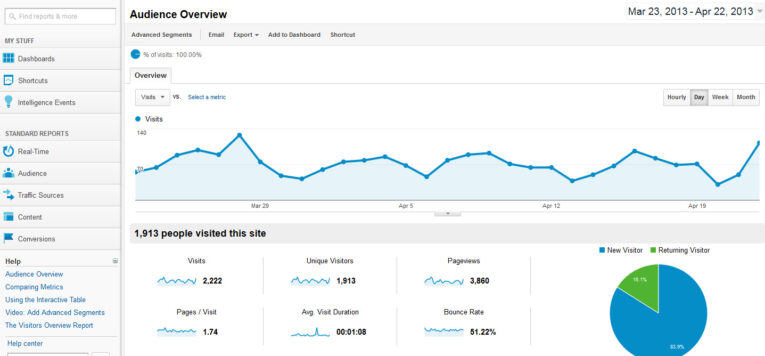Google Analytics – How to Read and Use the Information
Please note due to updates in Google Dashboard Area, some of these items have changed. Please find an updated post Here.
On April 25th, 2013 I gave a webinar on Google Analytics – How to read and use the information. While Google Analytics can be used for many purposes, the topics discussed here include:
- What is Google Analytics?
- Why is Google Analytics Important?
- Viewing the Dashboard in Google Analytics
- Dissecting the Audience tab in Google Analytics
- Reading the Traffic Sources Section in Google Analytics
- Content – Viewing your top content and creating more
- Drawing Conclusions from Google Analytics Data
You can view the video recording of the webinar here: http://www.anymeeting.com/paperstreet/ED58D681874D
What is Google Analytics?
Simply put, Google Analytics allows you to track visits to your website. The data collected in Google Analytics is separated into many different categories and demographics which you can sort through in the Google Analytics Dashboard area.
Why is Google Analytics Important?
Google Analytics is important because it offers a free way to collect valuable marketing data to measure your advertising ROI. Using Google Analytics you can make informed business decisions for your business’ web presence.
Viewing the Dashboard in Google Analytics

Dissecting the Audience Tab in Google Analytics
The Audience Tab in Google Analytics separates your traffic data into sections based on many different demographics, technologies and other key indicators which distinguish various groups.
The Language Tab can be used to calculate what the primary language of users visiting your site is. If you have an overwhelming amount of traffic from a specific foreign language, perhaps you should consider adding a translator to your site, or at least a page dedicated to users in that language.
The Location Tab can be used to show you where the people who are visiting your site are located. This information can be useful to hone in on geographic locations for local business SEO campaigns.
The Mobile Tab can be used to see the number of visits your site receives from mobile devices. If you receive a great deal of mobile visits, then you might consider building a responsive website or a mobile version of your site.
Reading the Traffic Sources Section in Google Analytics
Traffic Sources are separated into 3 main areas:
- Search Traffic – The amount of traffic coming to your site from a search engine, such as Google. You can easily view what key terms people are searching for, and how they are finding your site.
- Referral Traffic – Referral traffic refers to any visitors who landed on your site by clicking a link from another site – perhaps a listing in a directory, or a link from another website.
- Direct Traffic – This means someone typed in your exact URL to get to your website.
Content – Viewing your top content and creating more
One of the most common questions I am asked is ‘what should I write about.’ The answer can be found in Google Analytics. The content tab of Google Analytics will show you your website’s top viewed content. If you have written an article which receives a lot of traffic, perhaps it would be beneficial to expand on that topic with an additional post or write more posts about similar topics to try and increase traffic.
Contact PaperStreet Today
PaperStreet’s team of legal SEO experts will provide you and your law firm with the knowledge and power to dominate search rankings. If you are interested in a free consultation and learning more about how PaperStreet can help your Law Firm achieve top rankings in Google please Contact Us Today.







